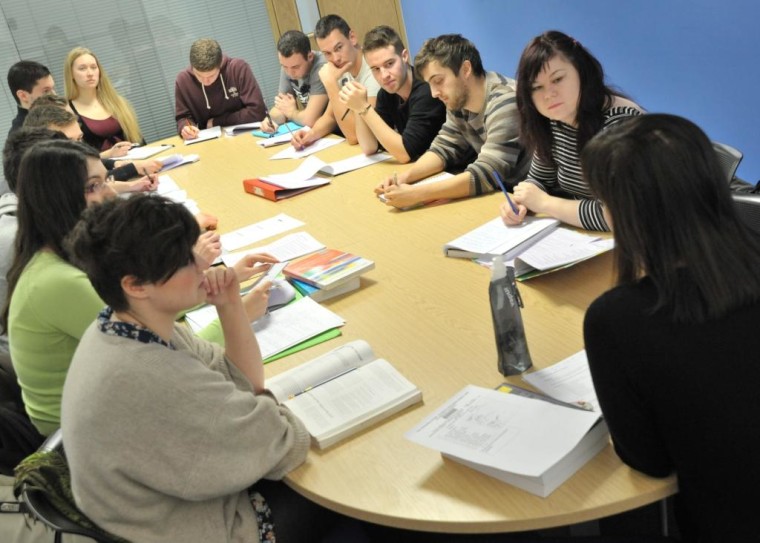Most of us do not give much thought to our teaching philosophy until we have to sit down and write such a document. In my role with our teaching center, I often have colleagues ask for tips and advice on how to write a statement of teaching philosophy. In today’s post, I want to share my teaching philosophy statement. It isn’t perfect and could use improvement. However, I hope it will be helpful to think about writing your own teaching philosophy.

My Teaching Philosophy Statement
As a professional field, higher education requires students to understand and apply research and theory to practice.
The development of scholar-practitioners and practitioner-aware scholars are of paramount concern.
My teaching philosophy is that the best learning occurs when students are challenged to apply content and concepts to the real world.
I view my role as a guide ensuring that the class stays on the path. Both students and instructor are responsible for reaching our destination, and students should focus on the goals of learning and less on product and grade.
Professors should foster this sense by placing greater emphasis on improvement and active participation as opposed to rigid repetition and regurgitation. In addition, my responsibility is to learn from my students in order to improve my teaching and my understanding of the views of practitioners currently working in the field.
My classroom dynamics reflect an understanding that students learn differently. However, I believe everyone benefits from active engagement with the course material and one another.
In a graduate program, students are colleagues and should be treated accordingly. In addition, the fostering of social connections and extra-curricular activities in the program facilitates student learning inside and outside the classroom.
Professors should be available to their students before, during, and after class.
Additionally, we should not overestimate the seriousness of the work we do and remember the humor necessary to maintain a proper balance.
Overall, professors should support students inside and outside the classroom, mentor students, and push them to achieve their professional and personal pursuits.
Instructional Approaches
The relationship between professor, subject matter, and student is a primary consideration in fostering learning and as a result my instructional approach mirrors this belief.
During each class session, I present a challenge, puzzle, or problem that students are unable to solve without utilizing and engaging with the subject matter. My role is to be keenly aware of student responses and comments in order to connect with students and improve their learning and understanding.
This approach takes various forms depending on the nightly topic.
For example, in EDU 6392: Foundations and History of American Higher Education, one of the topics is “Higher Education for a Freed People.” I split the class into two groups where one represents Booker T. Washington and the other W.E.B. Dubois.
The class debates the merits of the postsecondary philosophies espoused by Washington and Dubois through the use of primary source material with students often vigorously arguing for their assigned position.
In all of my classes, I make extensive use of case studies based on problems of practice and the research literature. Administrators do not often face neat and simple problems that have clear right and wrong answers.
Case studies allow students to work with messy problems found in the real world.
This necessitates that students rely on the research literature, their own experience, and the experience of others in the class in the pursuit of positive outcomes.
I do not believe my role is that of sage dispensing information to students and as a result I tend to avoid lecture and other formal classroom activities.
Instead, I focus on improving the decisions that students make by cultivating their understanding of content, theory, research, and practice.
My goal is for students to leave the classes I teach with growth in two skills: the ability to write academically and the ability to think critically about higher education as a system.
To improve student writing, I spend a significant amount of time working individually with students both in and out of class to assist with their writing.
In my writing assignments, I have students submit multiple drafts to learn a better writing process. When grading first drafts, I use video grading to leverage technology benefits of giving feedback. With video grading, I can record my comments with the student’s paper. This allows me to give specific and actionable edits for improving writing.
Helping students with their writing is a hallmark of my classes and an aspect of my teaching that students note as valuable.
To encourage my students to think critically about the system of higher education, I have them read InsideHigherEd, a free online news site for higher education. We spend ten minutes at the beginning of each class discussing the week’s issues and their impact on higher education.
Moreover, during class discussions or when using case studies, I encourage students to think about institutions different than those that they have experienced as a student or professional.
When engaging with course content, I urge them to consider the broad impact of ideas and concepts across the range of institutions that comprise higher education.
I believe this helps students critically analyze issues and make better decisions as administrators.

